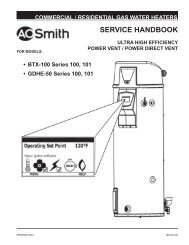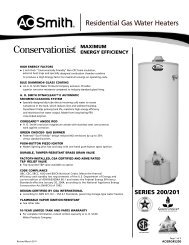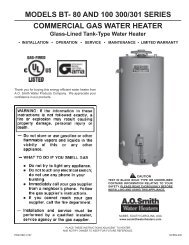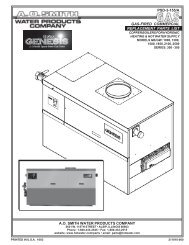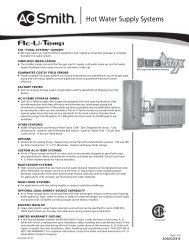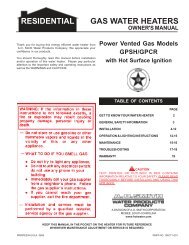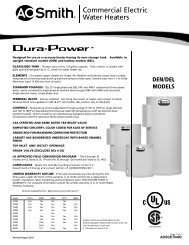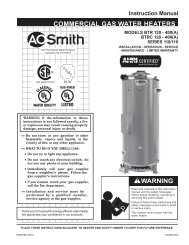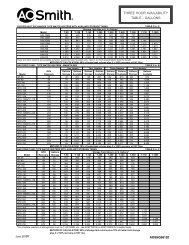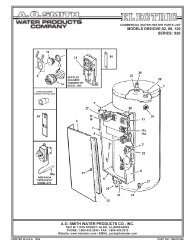Non-Condensing Models - AO Smith Water Heaters
Non-Condensing Models - AO Smith Water Heaters
Non-Condensing Models - AO Smith Water Heaters
Create successful ePaper yourself
Turn your PDF publications into a flip-book with our unique Google optimized e-Paper software.
Troubleshooting Guide• The flow adjustment valve could be obstructed due to hard water scale or debris, causing lowerthan expected water flow. Verify water flow with a graduated container or with the remotetemperature controller, if one is installed.• The output thermistor could be compromised. This component may be checked by entering theDiagnostics Mode on a remote controller, if one is installed. Turn power off to the unit and runcold water through it; check to see if the inlet and outlet temperatures read the same on theremote. For instructions on how to do this, refer to the Maintenance Sheet, packaged withevery water heater and located behind the front panel of the unit.TEMPERATURE FLUCTUATES WHEN A FIXTURE IS OPENED• Make sure the unit is installed properly using the Proper Installation section (p. 6) of this guide.• Check the flow and temperature right at the unit at the pressure relief valve. If the flow rateand temperature are correct at the PRV, then the problem resides elsewhere in the plumbingline. The following could be plumbing line problems:o Check for cross plumbing between cold water lines and hot water lines. See theProcedures section (p. 21) for instructions.o Check to see that a check valve is installed between the pump discharge and theconnection to the cold water supply. Inspect the check valve for proper operation. Ifthere isn’t one installed, or if it is malfunctioning, cold water may be back‐feeding intothe system.o Problems with a recirculation system:• Check that a check valve is installed between the pump discharge and theconnection to the cold water supply.• Check to see if the pump is operating properly.• Check for air cavitation. The pump will be very hot or chattering.• Check the directional indicator on the pump flange.• Check the sizing of the pump – a minimum flow of 2 gpm is required.• Check gas supplyo Verify the gas supply lines are sized for the maximum Btu/h demand, as indicated in theProper Installation section (p. 6) of this guide (See the specification page p.3 at thebeginning of this manual for gas input rating).o For LP models, there may not be enough gas left in the propane tank.o Verify that the supply gas pressure is within specification, not only when the heater is instandby, but while the heater is running on maximum fire as well. This may be causedby a malfunctioning gas supply regulator.• Ventingo Verify that the exhaust venting is installed to manufacturer’s specification.o Verify that the vent run does not exceed the maximum limit (50 ft.)• The filter on cold water inlet should be clean; look for signs of hard water scaling.• Check to make sure that the clear tube between the proportional gas valve and the bottom ofthe combustion chamber is connected.• On well systems or even on some city water systems, water pressure fluctuations (especially onlow flow) of 8 to 10 psi will result in flow rate fluctuations, which will in turn result in minortemperature fluctuations.• Flow sensor or water control valve may be compromised. Contact the Technical Department.9| Page



